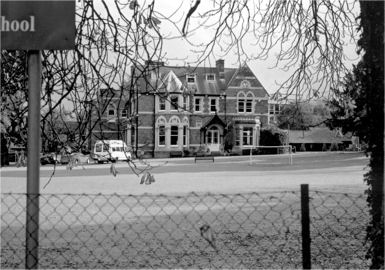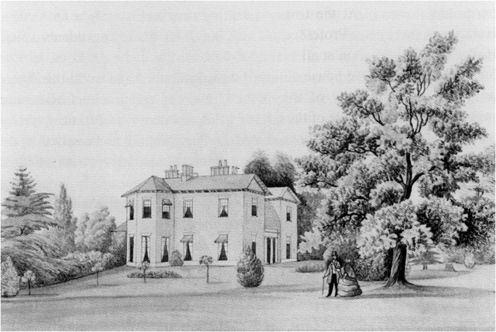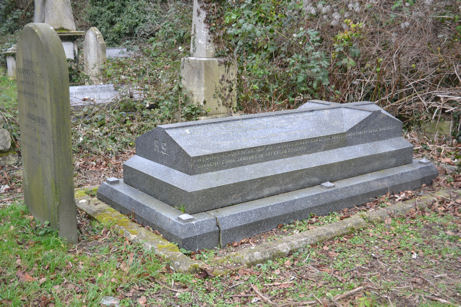
| Trumpington Local History Group Trumpington Personalities: Robert Sayle (1816-83) |
| Copyright © Trumpington Local History Group, 2014. Updated 1 July 2014. Email: admin@trumpingtonlocalhistorygroup.org |
Howard Slatter
Robert Sayle (1816-83) was a draper and philanthropist who lived in
Trumpington. This paper is based on a presentation given at a Group
meeting on 22 November 2012.
Robert Sayle (1816-83) was a draper and philanthropist who lived in
Trumpington. This paper is based on a presentation given at a Group
meeting on 22 November 2012.
| The Sayle family home, Leighton House, Trumpington Road, in the early 2000s. Edmund Brookes. |
Most of us remember the Robert Sayle store in St Andrew's Street, Cambridge, now replaced
by the John Lewis store which opened in 2007. But who was Robert Sayle?
Robert Sayle was born 22 Feb 1816 in Southery, Norfolk. His father was John Sayle, farmer
and landowner. Robert went to school in Ely and moved to London from 1838-1840, working
with drapers Hitchcock, Williams & Co. On Saturday 21 March 1840, Robert Sayle took over
the premises of draper John Cooch at Victoria House, St Andrew's Street, Cambridge, and
began his local career. The Cambridge Advertiser & Free Press carried a typically effuse
Victorian advert:
"ROBERT SAYLE
begs to inform the inhabitants of Cambridge and its vicinity that he has taken the premises lately
occupied by Mr John Cooch, which having undergone considerable alterations so as to afford
increased accommodation, he intends re-opening on Saturday, 21st instant, with a new
well-selected stock of:-
LINEN DRAPERY, SILK MERCERY, HOSIERY, HABERDASHERY, STRAW BONNETS
ETC. ETC.
In respectfully soliciting the patronage of the Nobility, Gentry and Inhabitants of the Town,
County and University of Cambridge, R.S. begs to assure them that, being thoroughly
acquainted with the various descriptions of goods connected with his business, he will be
enabled to select the best fabrics; and intends purchasing such as he can with confidence
recommend, his object being to ensure the repetition of such
favours as may be conferred upon him."
He goes into some detail of what he is selling, then at the end says:
"R.S. merely adds, that he intends conducting his business upon the principle so generally
adopted and approved, that of selling entirely for READY MONEY - affixing the smallest profit
to each article; and he trusts that by attention and perseverance he shall receive that
encouragement which it will be the height of his ambition to merit."
The Robert Sayle store started at 12 Victoria House and by stages took over the adjoining
premises, adding departments such as carpets and undertakers as it grew. By 1888, five years
after the death of the founder, the store extended all the way to number 17.
When the Cambridge Plate Glass Mutual Insurance Society founded March 1851, Sayle was a
founder member.
In 1849, he married Priscilla Caroline Ginger, of Eddlesborough, Bucks. They had 10 children,
all but one of whom lived to adulthood. They initially lived over the shop until the early 1860s
when moved into 10 St Andrew's Street, next door but one to the shop.
In the mid 1860s, he bought a plot of land in Trumpington and built Leighton House. In 1954,
this became the Perse Boys Preparatory School, when the letters RS over the front door were
cunningly amended to PS.
by the John Lewis store which opened in 2007. But who was Robert Sayle?
Robert Sayle was born 22 Feb 1816 in Southery, Norfolk. His father was John Sayle, farmer
and landowner. Robert went to school in Ely and moved to London from 1838-1840, working
with drapers Hitchcock, Williams & Co. On Saturday 21 March 1840, Robert Sayle took over
the premises of draper John Cooch at Victoria House, St Andrew's Street, Cambridge, and
began his local career. The Cambridge Advertiser & Free Press carried a typically effuse
Victorian advert:
"ROBERT SAYLE
begs to inform the inhabitants of Cambridge and its vicinity that he has taken the premises lately
occupied by Mr John Cooch, which having undergone considerable alterations so as to afford
increased accommodation, he intends re-opening on Saturday, 21st instant, with a new
well-selected stock of:-
LINEN DRAPERY, SILK MERCERY, HOSIERY, HABERDASHERY, STRAW BONNETS
ETC. ETC.
In respectfully soliciting the patronage of the Nobility, Gentry and Inhabitants of the Town,
County and University of Cambridge, R.S. begs to assure them that, being thoroughly
acquainted with the various descriptions of goods connected with his business, he will be
enabled to select the best fabrics; and intends purchasing such as he can with confidence
recommend, his object being to ensure the repetition of such
favours as may be conferred upon him."
He goes into some detail of what he is selling, then at the end says:
"R.S. merely adds, that he intends conducting his business upon the principle so generally
adopted and approved, that of selling entirely for READY MONEY - affixing the smallest profit
to each article; and he trusts that by attention and perseverance he shall receive that
encouragement which it will be the height of his ambition to merit."
The Robert Sayle store started at 12 Victoria House and by stages took over the adjoining
premises, adding departments such as carpets and undertakers as it grew. By 1888, five years
after the death of the founder, the store extended all the way to number 17.
When the Cambridge Plate Glass Mutual Insurance Society founded March 1851, Sayle was a
founder member.
In 1849, he married Priscilla Caroline Ginger, of Eddlesborough, Bucks. They had 10 children,
all but one of whom lived to adulthood. They initially lived over the shop until the early 1860s
when moved into 10 St Andrew's Street, next door but one to the shop.
In the mid 1860s, he bought a plot of land in Trumpington and built Leighton House. In 1954,
this became the Perse Boys Preparatory School, when the letters RS over the front door were
cunningly amended to PS.
| Leighton House, the Perse Preparatory School, 1950s. |



| Leighton House, the Perse Preparatory School, early 2000s. Edmund Brookes. |
In the 1881 census, Robert Sayle was a JP and General Merchant and Farmer. As well as being
a man of substantial means, he was a man of morals and of liberal religious tolerance. He was
an Anglican, but with a strong interest in and sympathy for other denominations, particularly the
Wesleyans.
Robert Sayle subscribed to the Royal Albert Almshouses built at the junction of Hills Road and
Brooklands Avenue (foundation stone 1859). In 1862, he supported the Operatives' Relief Fund
(for the relief of distressed operatives in the cotton industry in Lancashire and Cheshire, when
the American Civil War cut off supplies of raw cotton from the USA). In 1865, he helped the
Methodist Conference acquire a suitable piece of building land for a large Wesleyan Chapel in
Hills Road (demolished in the 1970s). In 1872, he was instrumental in buying a house and its
extensive grounds on Trumpington Road and selling it on to the Methodist Conference, who
developed it as The Leys School. He was also a prime mover in setting up town scholarships to
the Perse School 1871.
a man of substantial means, he was a man of morals and of liberal religious tolerance. He was
an Anglican, but with a strong interest in and sympathy for other denominations, particularly the
Wesleyans.
Robert Sayle subscribed to the Royal Albert Almshouses built at the junction of Hills Road and
Brooklands Avenue (foundation stone 1859). In 1862, he supported the Operatives' Relief Fund
(for the relief of distressed operatives in the cotton industry in Lancashire and Cheshire, when
the American Civil War cut off supplies of raw cotton from the USA). In 1865, he helped the
Methodist Conference acquire a suitable piece of building land for a large Wesleyan Chapel in
Hills Road (demolished in the 1970s). In 1872, he was instrumental in buying a house and its
extensive grounds on Trumpington Road and selling it on to the Methodist Conference, who
developed it as The Leys School. He was also a prime mover in setting up town scholarships to
the Perse School 1871.

| The Leys, Trumpington Road, c. 1850. By Permission of The Leys School Archive. |

| The Leys School, Trumpington Road, c. 1875. By Permission of The Leys School Archive. |
Robert Sayle rented a farm opposite the Wesleyan Chapel in Hills Road. In 1871, there was a
newspaper report of him being summoned before the County Magistrates for neglecting to
report the existence of Foot & Mouth disease in 5 of his cows, which were among several head
of stock grazing in a field in Grantchester. Mr Sayle "has a farm in Trumpington, another near
the Cambridge Railway Station, and we believe a third farm at Southery, Norfolk". The Bench
dismissed the case.
He subscribed generously to the funds of a Wesleyan chapel in Southery. He supported the
opening of the Perse Girls' school in 1881. He was one of the guarantors of the YMCA building
in St Tibbs Row, behind his shop. He was a great supporter of road improvements and street
lighting in Cambridge.
In 1869, Robert Sayle opened an office in Aldersgate, London. He used this as a springboard
for opening offices in Hong Kong and Shanghai in the early 1870s and Singapore by the 1880s,
exporting "Manchester goods" (cotton) and importing hand woven silks.
In 1883 he had two unexpected heart attacks in quick succession and he died on 5 Oct 1883.
Robert Sayle was buried in Mill Road cemetery, Cambridge.
newspaper report of him being summoned before the County Magistrates for neglecting to
report the existence of Foot & Mouth disease in 5 of his cows, which were among several head
of stock grazing in a field in Grantchester. Mr Sayle "has a farm in Trumpington, another near
the Cambridge Railway Station, and we believe a third farm at Southery, Norfolk". The Bench
dismissed the case.
He subscribed generously to the funds of a Wesleyan chapel in Southery. He supported the
opening of the Perse Girls' school in 1881. He was one of the guarantors of the YMCA building
in St Tibbs Row, behind his shop. He was a great supporter of road improvements and street
lighting in Cambridge.
In 1869, Robert Sayle opened an office in Aldersgate, London. He used this as a springboard
for opening offices in Hong Kong and Shanghai in the early 1870s and Singapore by the 1880s,
exporting "Manchester goods" (cotton) and importing hand woven silks.
In 1883 he had two unexpected heart attacks in quick succession and he died on 5 Oct 1883.
Robert Sayle was buried in Mill Road cemetery, Cambridge.

| Robert Sayle's grave, Mill Road cemetery, Cambridge, February 2011. Andrew Roberts. |